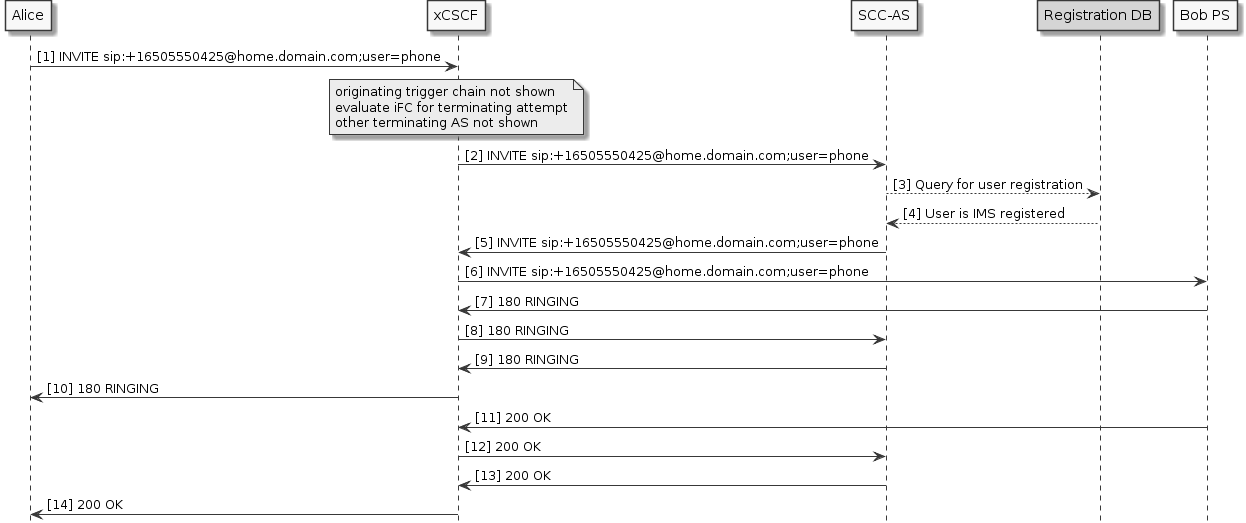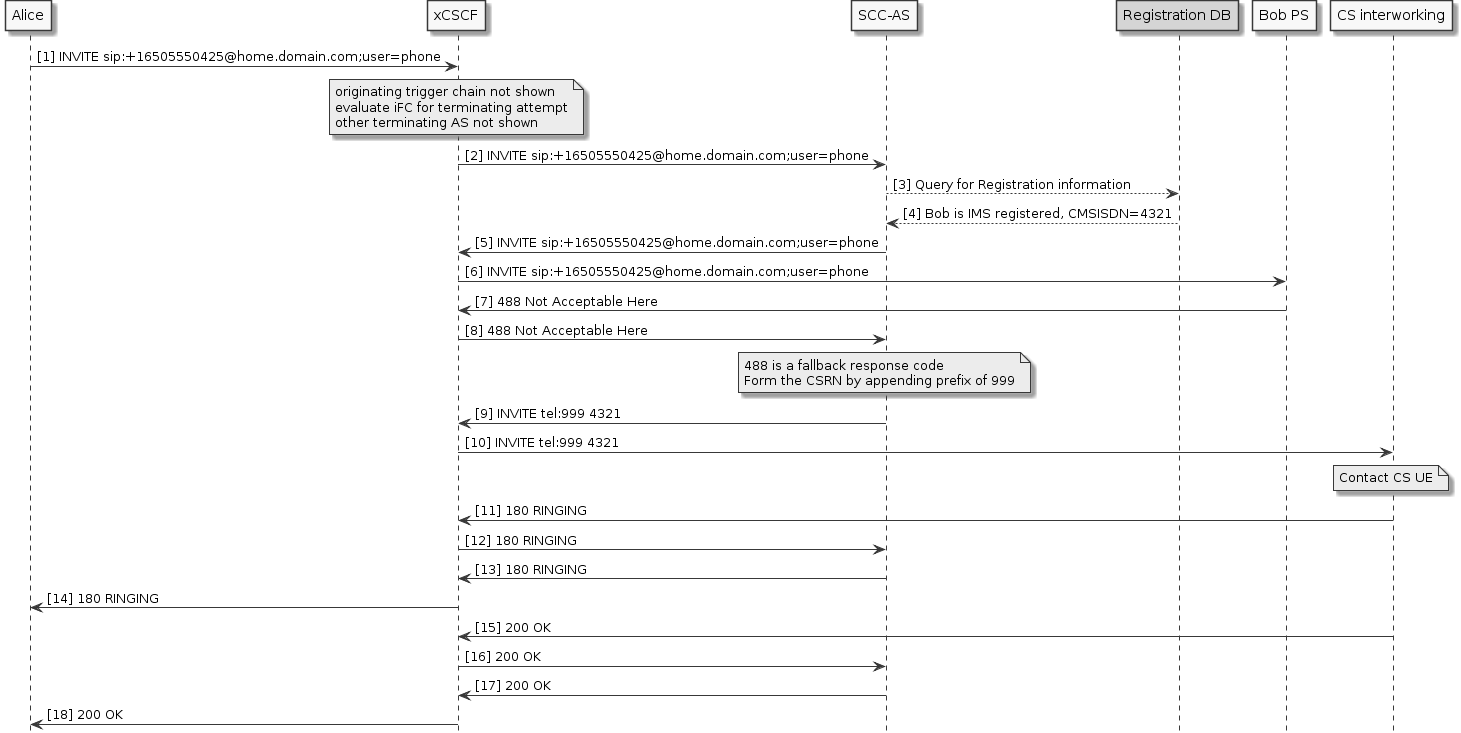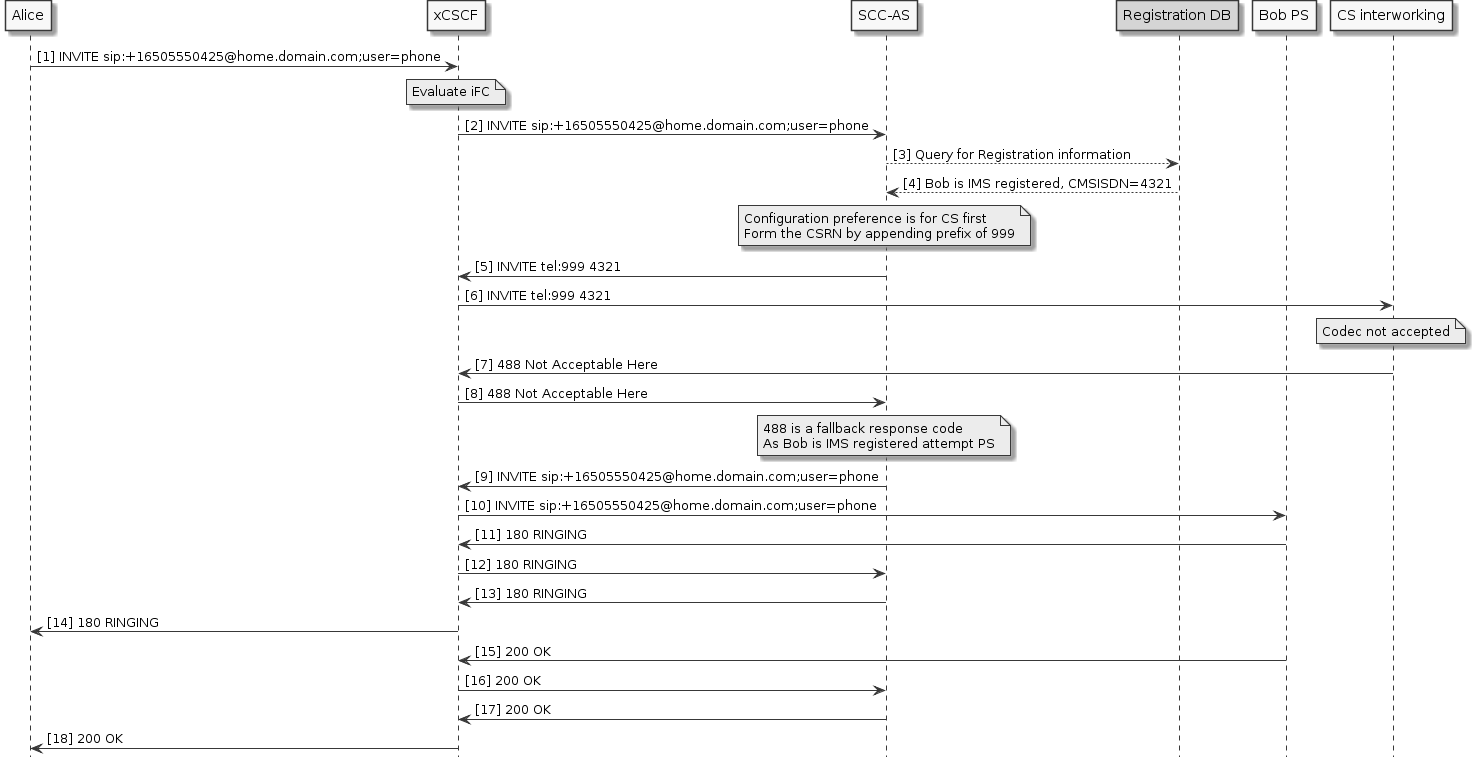T-ADS Routing executes after T-ADS data lookup feature and performs sequential forked routing.
It takes the T-ADS preferred routing decision from SCCTADSDataLookup, and uses it to attempt routing.
It makes the necessary adjustments for PS or CS routing to the outgoing INVITE as required.
Feature Cheat Sheet
| B2BUA Instance | Originating / Terminating | Point(s) in Session Plan | Network Operator Data | Subscriber Data | Stateful or Stateless | POJO Feature or SBB Feature | Other notes |
|---|---|---|---|---|---|---|---|
SCC |
Terminating only |
|
Yes |
No |
Stateless |
POJO |
The feature itself is stateless, but an FSM is encoded into session state |
Session Input Variables
| Session State variable name | Type | Comments |
|---|---|---|
CallType |
CallType (Enum) |
The call-type for the incoming call (e.g. MobileTerminating). |
RoutingMode |
TADSRoutingMode (Enum) |
Determines whether CS and/or PS routing is enabled and the preferred attempt order. |
SentinelSelectionKey |
SentinelSelectionKey |
Used to acquire configuration information. |
TADSCircuitRoutes |
Queue<String> |
Contains all valid CS domain routes (CSRNs). |
TADSPacketRoutes |
Queue<RouteAndTerminatingDomain> |
Contains all valid PS domain routes along with the network type for each route. |
TADSSipInstanceRoutingPossible |
boolean |
Indicates whether T-ADS +sip.instance routing is possible for the served user. |
BlindPSRouting |
boolean |
True if Blind PS Routing behaviour is to be used. |
FeatureCapsManager |
FeatureCapsManager |
Management interface for controlling Feature-Caps header values on outgoing messages. |
RegistrationRecords |
List<RegistrationRecord> |
List of registered devices for the served user, determines the maximum number of downstream forks to wait for when routing on the preferred domain. |
Session Output Variables
| Session State variable name | Type | Comments |
|---|---|---|
TerminatingDomain |
String |
Records the current value being used for the OC-Terminating-Domain Header |
FeatureCapsManager |
FeatureCapsManager |
Management interface for controlling Feature-Caps header values on outgoing messages. |
Network Operator Data
T-ADS Routing has network operator data in a JSLEE profile table named SCCTADSRoutingConfigProfileTable.
The data is scoped by Sentinel selection key.
| Attributes | Type | Meaning |
|---|---|---|
TimerTADS |
int |
The time in milliseconds that the feature will wait for an acceptable response when routing to the preferred leg. This value is required to be between 500 and 5000 ms. |
BlindRoutingCSFallbackResponseCodes |
int[] |
The list of SIP error response codes that will be checked if Blind PS Routing is used |
RouteCSDirectlyThroughICSCF |
boolean |
When true, T-ADS will route requests to the CS domain directly via the I-CSCF (bypassing the S-CSCF) |
T-ADS Routing also draws additional network operator data from SIP service configuration in a J-SLEE profile table named SipSentinelConfigurationTable.
The data is scoped by Sentinel selection key.
| Attributes | Type | Meaning |
|---|---|---|
IcscfUri |
String |
The |
Statistics
SCCTADSRouting statistics are tracked by the SCCTADSRouting SBB and can be found under the following parameter set: SLEE-Usage → volte.sentinel.sip service ID → SCCTADSRouting SBB ID.
| Name | Description |
|---|---|
Started |
Incremented when the feature is triggered. |
FailedToStart |
Incremented when the feature fails to start. |
FailedDuringExecution |
Incremented when the feature fails while executing. |
IssuedWarning |
Incremented when the feature issues a warning. |
TimedOut |
Incremented when the feature times out during execution. |
RouteToPreferredPS |
Incremented when the feature successfully to routes to a preferred leg when PS is preferred. |
RouteToPreferredCS |
Incremented when the feature successfully to routes to a preferred leg when CS is preferred. |
RouteToFallbackPS |
Incremented when the feature successfully to routes to a fallback leg when PS is preferred. |
RouteToFallbackCS |
Incremented when the feature successfully to routes to a fallback leg when CS is preferred. |
ErrorResponseMatched |
Incremented when the PS call error response code matches a value in |
Error18xMatched |
Incremented when the PS call 18x response matches the SDP requirements outlined in 18x Response. |
Received18xResponse |
Incremented when the feature receives a 18x response to the initial |
Received488Response |
Incremented when the feature receives a 488 message from the PS call. |
ReceivedBlindPSRoutingResponse |
Incremented when the feature receives a error message from the PS call that is contained in |
TerminatingDomainHeaderSet |
Incremented when the feature adds a terminating domain header to an upstream response |
TADSTimerFired |
Incremented when the Max Wait Timer for a response on a routing attempt is exceeded |
Behaviour
The following behaviour is described below:
Sequential routing strategies
The default routing strategy in VoLTE is to try to route to PS domain first and fallback to CS domain. This behaviour can be changed by the value of the parameter oc-tads-routing in the Route Header Parameters.
Based on the value of the RoutingMode session state field (calculated from the content of oc-tads-routing parameter), one of the following sequential routing modes is selected:
PS Domain only
RoutingMode = PS-ONLY
The feature tries to route towards the PS domain with no fall back to the CS domain.
100-TRYING responses and QoS negotiation are not shown in the flow.

CS Domain only
RoutingMode = CS-ONLY
The feature tries to route towards the CS domain with no fall back to PS domain.
100-TRYING responses and QoS negotiation are not shown in the flow.

PS network first with fallback to CS network
RoutingMode = PS-CS
The feature tries the PS domain first and drops to CS if the PS conditions don’t match. This allows the setting of Package Switch network as a preferred domain but also allows the usage of a Circuit Switch network if the user is available. This is the default mode.
100-TRYING responses and QoS negotiation are not shown in the flow.

CS network first with fallback to PS network
RoutingMode = CS-PS
The feature tries the CS domain first and drops to PS if the CS conditions don’t match. This allows the setting of Circuit Switch network as a preferred domain but also allows the usage of a Package Switch network if the user is logged in.
100-TRYING responses and QoS negotiation are not shown in the flow.

Selected Domain is CS
If T-ADS chooses to deliver on the CS domain, the T-ADS Routing feature will iterate through the CSRNs queued in the TADSCircuitRoutes session state field.
Going one at a time, for each CSRN the feature will:
-
Create an
INVITEto the called party using the CSRN as theRequest-URIand also as theToheader. -
If
RouteCSDirectlyThroughICSCFis enabled in feature configuration, theRouteheader will be modified to direct the request to the configuredIcscfUri. -
Add a
Request-Dispositionheader indicatingno-fork. -
Send the
INVITEand await a response. -
Handle responses according to behaviour outlined below.
The feature will iterate to the next CSRN if the call fails but meets the conditions for fallback.
If all possible CSRNs are exhausted and the routing strategy is CS-PS, the feature will fall-back to PS routing.
Note that the response handling for 488 and 18x Responses is the same when the PS domain is selected and the same fallback rules are applied.
Selected Domain is PS
If T-ADS chooses to deliver on the PS domain, the T-ADS Routing feature will iterate through the URIs queued in the TADSPacketRoutes session state field.
Going one at a time, for each URI the feature will:
-
Create an
INVITEto the called party using the URI as theRequest-URIand also as theToheader. -
If
TADSSipInstanceRoutingPossibleistruein session state, add aRequest-Dispositionheader indicatingno-fork. -
Send the
INVITEand await a response. -
Handle responses according to behaviour outlined below.
The feature will iterate to the next URI if the call fails but meets the conditions for fall-back.
If all possible URIs are exhausted and the routing strategy is PS-CS, the feature will fall-back to CS routing.
Response handling
The responses are handled the same way for PS and CS domains.
Max Wait Timer
Upon forwarding the INVITE request towards the preferred access network, the T-ADS routing feature arms a timer with the value from TimerTADS configuration.
If this timer expires before a response to the INVITE request is received, the INVITE will be cancelled and the feature will fall-back to the next available route.
The timer will be cancelled if a response is received before it expires, though it may be replaced with a new timer under the conditions outlined in the 18x Response section.
488 Response
After forwarding the INVITE, if the T-ADS Routing feature receives a 488 ("Not Acceptable Here") response from the UE that:
-
does not include any SDP body; OR
-
includes an SDP body:
-
without a media description (
m=) indicatingaudio; -
with a media description (
m=) only indicatingaudiowith the<proto>subfield set toPSTNand with a connection data line (c=) with<nettype>set toPSTN
-
The feature will not forward the response, and it will fall-back to the next available route.
A 488 response that does not meet the above conditions will be forwarded to the calling party.
18x Response
If the T-ADS Routing feature receives a 18x response it will evaluate it to determine if it is acceptable.
If the 18x response contains an SDP answer with a media description (m=) set to audio and port portion set to 0, then it is not acceptable.
In all other cases the 18x will be considered acceptable.
If the 18x is acceptable the call will proceed on the leg it was received on and T-ADS will complete execution.
If the 18x is not acceptable the feature will arm a timer using the TimerTADS feature configuration value as the duration.
The feature will then wait until:
-
a acceptable
18xresponse arrives, in which case the timer will be cancelled and the call will proceed, OR -
a non-
18xresponse arrives, which will be handled as described in its respective response handling section, OR -
the timer expires, OR
-
the number of forked responses is equal to the number of simultaneously registered devices for the served user.
If either of the last two conditions are met, the T-ADS Routing feature will send a CANCEL for the outbound INVITE, and fall-back to the next available route.
Blind PS Routing Response Handling
If the BlindPSRouting flag has been set, then the feature will additionally consider SIP response error codes that are contained in the configured BlindRoutingCSFallbackResponseCodes.
These error responses are inspected for the same condition as the 488 Response.
OC-Terminating-Domain header addition
The OC-Terminating-Domain header is added to responses heading upstream (usually for charging purposes). The feature adds this header to all responses for the original INVITE that are forwarded upstream.
For more details see OC-Terminating-Domain Header
